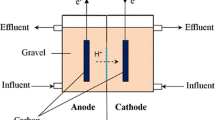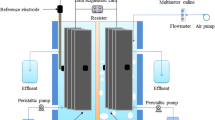Abstract
Simultaneous organics removal and bio-electrochemical denitrification using a microbial fuel cell (MFC) reactor were investigated in this study. The electrons produced as a result of the microbial oxidation of glucose in the anodic chamber were transferred to the anode, which then flowed to the cathode in the cathodic chamber through a wire, where microorganisms used the transferred electrons to reduce the nitrate. The highest power output obtained on the MFCs was 1.7 mW/m2 at a current density of 15 mA/m2. The maximum volumetric nitrate removal rate was 0.084 mg NO3 −–N cm−2 (electrode surface area) day−1. The coulombic efficiency was about 7%, which demonstrated that a substantial fraction of substrate was lost without current generation.








Similar content being viewed by others
References
Chaudhuri SK, Lovely DR (2003) Electricity generation by direct oxidation of glucose in mediatorless microbial fuel cells. Nat Biotechnol 21:1229–1232
Oh SE, Logan BE (2005) Hydrogen and electricity production from a food processing wastewater using fermentation and microbial fuel cell technologies. Water Res 39:4673–4682
Oh SE, Min BK, Logan BE (2004) Cathode performance as a factor in electricity generation in microbial fuel cells. Environ Sci Technol 38:4900–4904
Tartakovsky B, Guiot SR (2006) A comparison of air and hydrogen peroxide oxygenated microbial fuel cell reactors. Biotechnol Prog 22:241–246
Rabaey K, Lissens G, Siciliano SD, Verstraete W (2003) A microbial fuel cell capable of converting glucose to electricity at high rate and efficiency. Biotechnol Lett 25:1531–1535
Rabaey K, Clauwaert P, Aelterman P, Verstraete W (2005) Tubular microbial fuel cells for efficient electricity generation. Environ Sci Technol 39:8077–8082
Rhoads A, Beyenal H, Lewandowski Z (2005) Microbial fuel cell using anaerobic respiration as an anodic reaction and biomineralized manganese as a cathodic reactant. Environ Sci Technol 39:4666–4671
Lopez-lopez A, Exposito E, Anton J, Rodriguez-Valera F, Aldaz A (1999) Use of Thiobacillus ferrooxidans in a coupled microbiological–electrochemical system for wastewater detoxification. Biotechnol Bioeng 63:79–86
Gregory KB, Bond DR, Lovley DR (2004) Graphite electrodes as electron donors for anaerobic respiration. Environ Microbiol 6(6):596–604
Park HI, Kim DK, Choi YJ, Pak DW (2005) Nitrate reduction using an electrode as direct electron donor in a biofilm-electrode reactor. Process Biochem 40:3383–3388
Madigan MT, Martinko JM, Parker J (2003) Brock biology for microorganisms, 10th edn. Person Education, USA
Park DH, Zeikus JG (2003) Improved fuel cell and electrode designs for producing electricity from microbial degradation. Biotechnol Bioeng 81:348–355
Lee JY, Phung NT, Chang IS, Kim BH, Sung HC (2003) Use of acetate for enrichment of electrochemically active microorganisms and their 16S rDNA analyses. FEMS Microbiol Lett 223:185–191
APHA, WEF, ASCE (1998) Standard methods for the examination of water and wastewater, 20th edn. American Water Works Association, American Water Works Association and Water Environment Federation, Washington DC, USA
Min BK, Cheng SA, Logan BE (2005) Electricity generation using membrane and salt bridge microbial fuel cells. Water Res 39:1675–1686
Logan BE, Murano C, Scott K, Gray ND, Head IM (2005) Electricity generation from cysteine in a microbial fuel cell. Water Res 39:942–952
Bond DR, Lovley DR (2003) Electricity production by Geobacter sulfurreducens attached to electrodes. Appl Environ Microbiol 69:1548–1555
Acknowledgments
This subject is supported by Korea Ministry of Environment as “The Eco-technopia 21 project”.
Author information
Authors and Affiliations
Corresponding author
Rights and permissions
About this article
Cite this article
Jia, YH., Tran, HT., Kim, DH. et al. Simultaneous organics removal and bio-electrochemical denitrification in microbial fuel cells. Bioprocess Biosyst Eng 31, 315–321 (2008). https://doi.org/10.1007/s00449-007-0164-6
Received:
Accepted:
Published:
Issue Date:
DOI: https://doi.org/10.1007/s00449-007-0164-6




